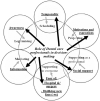Decision Making from the Experience of Orthognathic Surgery Patients: A Grounded Theory Approach
- PMID: 34027746
- PMCID: PMC9203665
- DOI: 10.1177/23800844211014440
Decision Making from the Experience of Orthognathic Surgery Patients: A Grounded Theory Approach
Abstract
Introduction: Patients' decisions to undergo major surgery such as orthognathic treatment are not just about how the decision is made but what influences the decision.
Objectives: The primary objective of the study was to identify the key processes involved in patients' experience of decision making for orthognathic treatment.
Methods: This study reports some of the findings of a larger grounded theory study. Data were collected through face-to-face interviews of patients who were seen for orthognathic treatment at a teaching hospital in the United Kingdom. Twenty-two participants were recruited (age range 18-66 y), of whom 12 (male = 2, female = 10) were 6 to 8 wk postsurgery, 6 (male = 2, female = 4) were in the decision-making stage, and 4 (male = 0, female = 4) were 1 to 2 y postsurgery. Additional data were also collected from online blogs and forums on jaw surgery. The data analysis stages of grounded theory methodology were undertaken, including open and selective coding.
Results: The study identified the central role of dental care professionals (DCPs) in several underlying processes associated with decision making, including legitimating, mediating, scheduling, projecting, and supporting patients' decisions. Six categories were related to key aspects of decision making. These were awareness about their underlying dentofacial problems and treatment options available, the information available about the treatment, the temporality of when surgery would be undertaken, the motivations and expectation of patients, social support, and fear of the surgery, hospitalization, and potentially disliking their new face.
Conclusion: The decision-making process for orthognathic treatment is complex, multifactorial, and heavily influenced by the role of DCPs in patient care. Understanding the magnitude of this role will enable DCPs to more clearly participate in improving patients' decision-making process. The findings of this study can inform future quantitative studies.
Knowledge transfer statement: The results of this study can be used both for informing clinical practice around enabling decision making for orthognathic treatment and also for designing future research. The findings can better inform clinicians about the importance of their role in the patients' decision-making process for orthognathic treatment and the means to improve the patient experience. It is suggested that further research could be conducted to measure some of the key constructs identified within our grounded theory and assess how these change during the treatment process.
Keywords: awareness; fear; information; role of dental professionals; social support; temporality.
Conflict of interest statement
Figures
Similar articles
-
Information-seeking behaviour in patients exploring orthognathic surgery: A qualitative study.J Orthod. 2025 Mar;52(1):63-71. doi: 10.1177/14653125241249494. Epub 2024 May 8. J Orthod. 2025. PMID: 38717064 Free PMC article.
-
Does the British Orthodontic Society orthognathic DVD aid a prospective patient's decision making? A qualitative study.J Orthod. 2014 Jun;41(2):88-97. doi: 10.1179/1465313313Y.0000000080. Epub 2014 Feb 12. J Orthod. 2014. PMID: 24521747
-
Shared decision making for patients needing dentofacial orthopedics, orthognathic surgery, and conventional non-surgical fixed appliance therapy: a comparison between Pakistani patients' and clinicians' perspective.Dental Press J Orthod. 2024 Sep 2;29(4):e242443. doi: 10.1590/2177-6709.29.4.e242443.oar. eCollection 2024. Dental Press J Orthod. 2024. PMID: 39230113 Free PMC article.
-
A scoping review of website-based orthognathic surgery information.Oral Surg Oral Med Oral Pathol Oral Radiol. 2025 Jul;140(1):19-32. doi: 10.1016/j.oooo.2024.12.022. Epub 2025 Jan 2. Oral Surg Oral Med Oral Pathol Oral Radiol. 2025. PMID: 40254473
-
Orthodontic Considerations for Cleft Orthognathic Surgery.Oral Maxillofac Surg Clin North Am. 2020 May;32(2):249-267. doi: 10.1016/j.coms.2020.01.013. Oral Maxillofac Surg Clin North Am. 2020. PMID: 32247439 Review.
Cited by
-
Decision experiences in joint replacement surgery for patients with haemophilic arthritis: A qualitative study.BMC Med Inform Decis Mak. 2025 Feb 4;25(1):55. doi: 10.1186/s12911-025-02901-3. BMC Med Inform Decis Mak. 2025. PMID: 39905363 Free PMC article.
-
In Vivo Accuracy of a New Digital Planning System in Terms of Jaw Relation, Extent of Surgical Movements and the Hierarchy of Stability in Orthognathic Surgery.J Pers Med. 2022 May 21;12(5):843. doi: 10.3390/jpm12050843. J Pers Med. 2022. PMID: 35629264 Free PMC article.
-
Information-seeking behaviour in patients exploring orthognathic surgery: A qualitative study.J Orthod. 2025 Mar;52(1):63-71. doi: 10.1177/14653125241249494. Epub 2024 May 8. J Orthod. 2025. PMID: 38717064 Free PMC article.
References
-
- Aldairy T, Laverick S, McIntyre GT. 2012. Orthognathic surgery: is patient information on the internet valid? Eur J Orthod. 34(4):466–469. - PubMed
-
- Bailey LJ, Proffit WR, White R., Jr. 1999. Assessment of patients for orthognathic surgery. Semin Orthod. 5(4):209–222. - PubMed
-
- Bergkulla N, Hanninen H, Alanko O, Tuomisto M, Kurimo J, Miettinen A, Svedstrom-Oristo AL, Cunningham S, Peltomaki T. 2017. Introduction and assessment of orthognathic information clinic. Eur J Orthod. 39(6):660–664. - PubMed
-
- Bhamrah G, Ahmad S, Nimhurchadha S. 2015. Internet discussion forums, an information and support resource for orthognathic patients. Am J Orthod Dentofac Orthop. 147(1):89–96. - PubMed
Publication types
MeSH terms
LinkOut - more resources
Full Text Sources
Other Literature Sources



